
 English
English
 French
French
Epidemiological aspects of smoking in schools in the 5th district of Niamey - Niger
Aspects épidémiologiques du tabagisme dans les écoles du 5ème arrondissement de Niamey - Niger
MM. Assao Neino1, I. Alkassoum Salifou2, MA. Gagara Issoufou1, Z. Idrissa Guisso1, DA. Maizoumbou1
1; Pneumo-Phtisiology Department of the National Lamorde Hospital (HNL). Niger
2; Epidemic Surveillance Monitoring Directorate. Niger
Corresponding author
Dr. M. MOURTALA Assao Neino
Pneumo-Phtisiology Department of the National Lamorde Hospital (HNL). Niger
Email : mourt2000@yahoo.fr
ABSTRACT
Smoking is a global public health problem. In Niger, smoking affects mainly young people. In fact, the phenomenon of smoking is starting now and earlier among schoolchildren and is now affecting not only boys but also girls. This led us to carry out this work which aims to study the epidemiological aspects of smoking in schools in the 5th district of Niamey. This was a prospective cross-sectional study of a 20-month self-administered questionnaire in grade 6 to 12 students. A total of 800 students aged 10 to 24 years had participated in the survey, and males accounted for 58%. The age group of 15-19 years accounted for 64.12%, the private sector accounted for 52.5% and the prevalence of smoking was 24.37%.
The private sector accounted for 54.36% of current smokers, the 15-19 age group accounted for 44.10% of current smokers. The chicha was consumed by 62.14% of students. Curiosity was the reason that prompted students to smoke their first cigarette in 44.23% of old and current smokers.
KEYWORDS: Epidemiology, smoking, school, 5th district, Niamey.
RÉSUMÉ
Le tabagisme constitue un problème de santé publique mondial.Au Niger le tabagisme affecte surtout les jeunes. En effet le phénomène du tabagisme commence actuellement de plus en plus tôt chez les scolaires et frappe désormais non seulement les garçons, mais aussi les filles. Ceci nous a poussés à réaliser ce travail dont le but est d’étudier les aspects épidémiologiques du tabagisme en milieu scolaire dans le 5ème arrondissement de Niamey. Il s’agissait d’une étude prospective transversale d’une période de 20 mois par questionnaire auto-administrée chez les élèves de la classe de 6ème à la terminale. Au total 800 élèves de 10 à 24 ans avaient participé à l’enquête et le sexe masculin représentait 58%. La tranche d’âge de 15-19 ans représentait 64,12%, le secteur privé représentait 52,5% et la prévalence du tabagisme était de 24,37%.Le secteur privé représentait 54,36% des fumeurs actuels, la tranche d’âge 15-19 ans représentait 44,10% des fumeurs actuels. La chicha était consommée par 62,14% des élèves. La curiosité était la raison qui avait poussé les élèves à fumer leur première cigarette dans 44,23% chez les anciens et actuels fumeurs.
Les élèves du 5ème arrondissement de Niamey s’initiaient au tabagisme à un âge précoce et la curiosité était la raison qui les avaient le plus poussé à fumer leur première cigarette. La prévalence du tabagisme était élevée et la chicha était largement la plus consommée parmi les autres produits du tabac.
MOTS CLÉS: : épidémiologie, tabagisme, scolaire, 5eme arrondissement, Niamey.
INTRODUCTION
Smoking is a global public health problem [1]. In Africa, around 845,000 people die each year from smoking [2]. Given the scale of the phenomenon and the colossal means that tobacco companies devote to the marketing of their products, Niger was one of the first African countries to ratify in August 2015, the Framework Convention on Tobacco Control (CCSA) [3].
According to a global survey conducted among school-aged children by the Nigerian Association for the Promotion of Public Health (ANPSP) in 2006, 14.5% of students commonly used a tobacco product [4]. In Niger, the phenomenon of smoking is beginning more and more early in school and now affects not only boys, but girls. That is why we initiated this work which aims to study the epidemiological aspects of smoking in schools in the 5th district of Niamey (Niger).
METHODS
This was a prospective cross-sectional study of a 20-month period (May 2016 to January 2018) by self-administered questionnaire among students from the 6th to the 6th year secondary school level (3 public and 3 private) of the 5th district of Niamey selected by random sampling.
Regular smokers are defined by people who smoke cigarettes at least once a day, occasional smokers are those who smoke, but not every day. The former smoker is any person who has consumed a tobacco product and no longer consumes it for a defined period of time prior to the date of the investigation and the non-smoker is a person who does not has never smoked a tobacco product in his life.
RESULTS
A total of 800 students aged 10 to 24 participated in the survey and males accounted for 58% with a sex ratio (M/F) of 1.38. The 15-19 age group accounted for 64.12%, the average age was 15.22 years, and the private sector was 52.5%.
The prevalence of smoking was 24.37% (13.37% FO and 11% FR) (Figure 1). The private sector accounted for 54.36% of current smokers. Female gender accounted for 7.69% of current smokers. The 15-19 age group accounted for 44.10% of current smokers. The age of initiation to smoking was 8-12 years in 21.2%; chicha was consumed by 62.14% of students; chewing tobacco by 19.03%; sniffing tobacco by 10.87 % and the pipe by 7.96% of students.
The night was the right time for smoking for current and former smokers in 39.13% (Figure 2). The daily consumption of cigarettes was 6 to 10 cigarettes in 38.75% of cases among regular smokers (Table 1).
Tobacco intoxication lasting 1-2 years accounted for 50.77% of current smokers (Figure 3).
Curiosity was the reason that had prompted students to smoke their first cigarette in 44.23% of current and former smokers (Table 4).
Current smokers tried to quit in 79.48% and it was the parents' council that led them to quit smoking in 39.60%.
The harmful effect of tobacco was reported by 92.30% of current smokers, 90.77% of former smokers and 94.26% of non-smokers. The pathological consequences of smoking on the respiratory, cardiac and other devices were cited by the students in respectively 90.40%, 5% and 4.6%. Students' knowledge of the negative effect of smoking on school performance was 71.71%. The ban on the sale or importation of tobacco was the suggestion made by 44.26% of students for the fight against tobacco.
DISCUSSION
In our study, the male sex represents 58%. Hassane in Niger [5] and Kodioau Mali [6] found respectively 57.70% and 72.3% with male predominance. This under-representation of girls may be due to the fact that their schooling is lower than that of boys in our regions. Traditions want the young girl to be a good housewife and ensure the education of her children. In addition they are married very early and therefore make early maternity forcing them to abandon the benches or even not to go at all. The prevalence of smoking in our study was 24.37%. Similar studies carried out by Hassane in Niger [5], Kaoutar in Morocco [7], Bouaoud in Algeria [8] found an overall prevalence of 14.9%, 8.6% and 25% respectively. This difference in prevalence between these different countries could be explained by the socio-cultural and religious factors, but also the periods during which the studies were undertaken.
In our study, the age group most affected by smoking is 15-19 years old in 44.10% of cases. This could be explained by the fact that generally, at these ages, the young person wants to assert himself, to pretend to be an "adult", to identify with his models. The youth is convinced that smoking is a proof of perfect integration into the modern world, elegance, relaxation, and virility. She gives him the assurance, a feeling of valorization.
It is the company of a smoking friend who is the circumstance that favored smoking in 34.52%. Our results are close to those of Hassane who found 35.3% of smokers smoke the most in the presence of a friend smoking [5].
The consumption of shisha was mentioned by 62.14%. This could be explained by the fact that students found shisha more pleasant than cigarettes and did not consider chicha as smoking. Curiosity is the main reason cited for smoking in 45.06%. Laminou in Niger made the same observations in 38.67% of cases [9].
In our study, 79.48% of students had tried to quit smoking at least once but without success. Kodio reported that 61% of smokers had tried to quit at least once [6]. These results show how much these students show the desire to break with their smoking habit.
In our study 92.30% of current smokers recognize that tobacco is harmful to health. Hassane made the same observations with 96.8% of students who knew the harmfulness of tobacco [5]. Thus, it is on this category of student that it is especially emphasized through awareness to push them to stop smoking.
CONCLUSION
Youth smoking is a problem in schools in the 5th district of Niamey. Shisha was largely the most consumed among other tobacco products. However, it is important to pay special attention to the growing consumption of shisha in our society, but especially among the school children who represent the elite of tomorrow.
CONCFLIT OF INTEREST
The authors declare no conflict of interest for this work.
REFERENCES
1. Murray, JL Christopher, Lopez, D Alan.alternative projections of mortality and disability by cause 19902020: Global Burden of Disease Study. Lancet 1997 May 24; 349(9064) :1498-1504.
2. Global YouthTabacco Survey (GYTS). Rapport de l’enquête sur le tabac chez les adolescents en milieu scolaire de Ouagadougou et de Bobo-Dioulasso au Burkina Faso. Mars 2005, 15pages.
3. Association SOS tabagisme Niger. La lutte anti-tabac au Niger. Niamey 14 juillet 2016,12pages .
4. Ministère de la Santé Publique du Niger. Rapport du Projet de programme national de lutte contre le tabagisme 2009-2014. Janvier 2009, page 1-21.
5. I Hassane. Contribution à l’étude épidémiologique du tabagisme des élèves des lycées de la communauté urbaine de Niamey, thèse de doctorat en médecine, Université Abdou Moumouni de Niamey. 2003.104 pages.
6. AKodio. Tabagisme en milieu scolaire de la commune V du district de Bamako, thèse de doctorat en médecine, Université de Bamako. 2010. 67pages .
7. K Kaoutar, M K Hilali, M Loukid, 2012. Tabagisme et facteurs associés des adolescents de la ville de Marrakech. Antropo, 28, 97-104. www.didac.ehu.es/ antropo.
8. S Bouaoud. Tabagisme chez les jeunes en milieu scolaire dans la Wilaya de Sétif, Rapport du 8eme congrès national de la SFT, Algérie 2014.
9. L Laminou. Contribution du tabagisme en milieu scolaire : cas du premier cycle du secondaire de la CUN. Thèse de Doctorat en médecine. Université Abdou Moumouni de Niamey.2004.109 pages.
FIGURES - TABLES

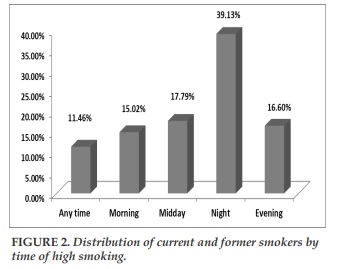
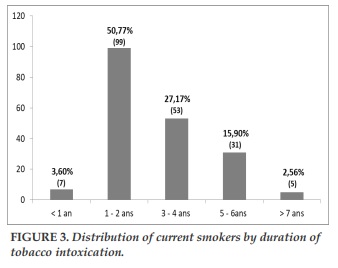
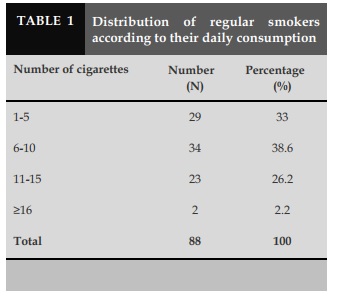
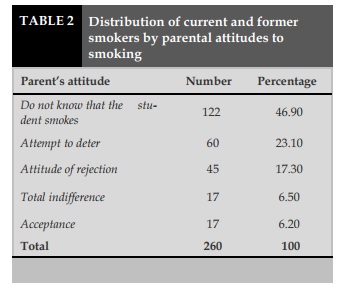
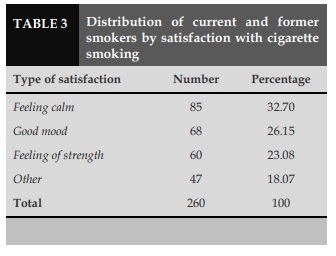

REFERENCES
1. Murray, JL Christopher, Lopez, D Alan.alternative projections of mortality and disability by cause 19902020: Global Burden of Disease Study. Lancet 1997 May 24; 349(9064) :1498-1504.
2. Global YouthTabacco Survey (GYTS). Rapport de l’enquête sur le tabac chez les adolescents en milieu scolaire de Ouagadougou et de Bobo-Dioulasso au Burkina Faso. Mars 2005, 15pages.
3. Association SOS tabagisme Niger. La lutte anti-tabac au Niger. Niamey 14 juillet 2016,12pages .
4. Ministère de la Santé Publique du Niger. Rapport du Projet de programme national de lutte contre le tabagisme 2009-2014. Janvier 2009, page 1-21.
5. I Hassane. Contribution à l’étude épidémiologique du tabagisme des élèves des lycées de la communauté urbaine de Niamey, thèse de doctorat en médecine, Université Abdou Moumouni de Niamey. 2003.104 pages.
6. AKodio. Tabagisme en milieu scolaire de la commune V du district de Bamako, thèse de doctorat en médecine, Université de Bamako. 2010. 67pages .
7. K Kaoutar, M K Hilali, M Loukid, 2012. Tabagisme et facteurs associés des adolescents de la ville de Marrakech. Antropo, 28, 97-104. www.didac.ehu.es/ antropo.
8. S Bouaoud. Tabagisme chez les jeunes en milieu scolaire dans la Wilaya de Sétif, Rapport du 8eme congrès national de la SFT, Algérie 2014.
9. L Laminou. Contribution du tabagisme en milieu scolaire : cas du premier cycle du secondaire de la CUN. Thèse de Doctorat en médecine. Université Abdou Moumouni de Niamey.2004.109 pages.
ARTICLE INFO
DOI: 10.12699/jfvpulm.9.29.2018.11
Conflict of Interest
Non
Date of manuscript receiving
21/7/2018
Date of publication after correction
15/12/2018
Article citation
Assao Neino MM,Alkassoum Salifou I, Gagara Issoufou MA, Idrissa Guisso Z, Maizoumbou DA. Epidemiological aspects of smoking in schools in the 5th district of Niamey - Niger. J Func Vent Pulm 2018;29(9):11-14.